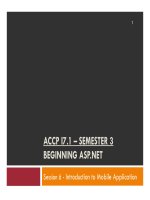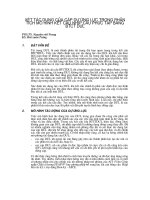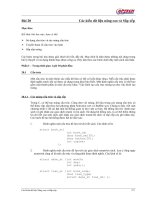Session16 container model, session, listener, JSP
Bạn đang xem bản rút gọn của tài liệu. Xem và tải ngay bản đầy đủ của tài liệu tại đây (256.67 KB, 37 trang )
JavaServer Pages (JSP)
ADVJ Session 5 –JSP
1/26
Objectives
• JavaServer Pages (JSP)
–
–
–
–
–
–
–
What JSP Technology is and how you can use it.
JSP Page
Translation Time
How JSP Works?
JSP Elements
JSP Predefined Variable – Implicit Objects
JSP Lifecycle
ADVJ Session 5 –JSP
2/26
Objectives
• Dispatching Mechanisms
– <jsp:forward>
– <jsp:include>
• JSPs in XML
ADVJ Session 5 –JSP
3/26
JavaServer Pages (JSP)
• What JSP Technology is and how you can use it.
– JavaServer Pages (JSP) technology provides a simplified,
fast way to create web pages that display dynamicallygenerated content.
– The JSP 1.2 specification is an important part of the Java 2
Platform, Enterprise Edition. Using JSP and Enterprise
JavaBeans technologies together is a great way to
implement distributed enterprise applications with webbased front ends.
– The first place to check for information on JSP technology
is />ADVJ Session 5 –JSP
4/26
JSP Page
• A JSP page is a page created by the web developer that
includes JSP technology-specific tags, declarations, and
possibly scriptlets, in combination with other static HTML or
XML tags.
• A JSP page has the extension .jsp; this signals to the web
server that the JSP engine will process elements on this page.
• Pages built using JSP technology are typically implemented
using a translation phase that is performed once, the first time
the page is called. The page is compiled into a Java Servlet
class and remains in server memory, so subsequent calls to
the page have very fast response times.
ADVJ Session 5 –JSP
5/26
Translation Time
• A JSP application is usually a collection of JSP files,
HTML files, graphics and other resources.
• A JSP page is compiled when your user loads it into a
Web browser
1. When the user loads the page for the first time, the files that
make up the application are all translated together, without
any dynamic data, into one Java source file (a .java file)
2. The .java file is compiled to a .class file. In most
implementations, the .java file is a Java servlet that complies
with the Java Servlet API.
ADVJ Session 5 –JSP
6/26
Simple JSP Page
<HTML>
<H1> First JSP Page </H1>
<BODY>
<%
out.println(“Welcome to JSP world”);
%>
</BODY>
</HTML>
ADVJ Session 5 –JSP
7/26
How JSP Works?
User
UserRequest
Request––JSP
JSPFile
FileRequested
Requested
Server
Server
Create
CreateSource
Sourcefrom
fromJSP
JSP
File
File
Changed
Changed
Compile
Compile
Execute
ExecuteServlet
Servlet
ADVJ Session 5 –JSP
8/26
JSP Elements
• Declarations
<%! code %>
• Expressions
<%= expression%>
• Scriplets
<% code %>
ADVJ Session 5 –JSP
9/26
HTML Comment
• Generates a comment that is sent to the client.
– Syntax
ADVJ Session 5 –JSP
10/26
Declaration
•
Declares a variable or method valid in the scripting language used in the JSP
page.
– Syntax
<%! declaration; [ declaration; ]+
... %>
– Examples
<%! String destin; %>
<%! public String getDestination()
{return destin;}%>
<%! Circle a = new Circle(2.0); %>
– You can declare any number of variables or methods within one
declaration
element, as long as you end each declaration with a semicolon.
– The declaration must be valid in the Java programming language.
ADVJ Session 5 –JSP
11/26
Declaration Demo
Demo\JSP1\dec.jsp
ADVJ Session 5 –JSP
12/26
Expression
•
Contains an expression valid in the scripting language used in the JSP page.
– Syntax
<%= expression %>
<%! String name = new String(“JSP World”); %>
<%! public String getName() { return name; } %>
<B><%= getName() %></B>
– Description:
An expression element contains a scripting language expression that is evaluated,
converted to a String, and inserted where the expression appears in the JSP file.
– Because the value of an expression is converted to a String, you can use an expression
within a line of text, whether or not it is tagged with HTML, in a JSPfile. Expressions are
evaluated from left to right.
ADVJ Session 5 –JSP
13/26
Expression Demo
Demo\JSP1\exp.jsp
ADVJ Session 5 –JSP
14/26
Scriptlet
• Contains a code fragment valid in the page scripting language.
– Syntax
<% code fragment %>
<%
String var1 = request.getParameter("name");
out.println(var1);
%>
•
This code will be placed in the generated servlet method:
_jspService()
ADVJ Session 5 –JSP
15/26
Scriplet Demo
Demo\JSP1\scriptlet.jsp
ADVJ Session 5 –JSP
16/26
JSP Predefined Variable – Implicit
Objects
•
request –
•
response –
•
out -
•
session -
•
application -
•
config -
•
pageContext -
•
page –
Object of HttpServletRequest (request parameters, HTTP headers, cookies
Object of HttpServletResponse
Object of PrintWriter buffered version JspWriter
Object of HttpSession associated with the request
Object of ServletContext shared by all servlets in the engine
Object of ServletConfig
Object of PageContext in JSP for a single point of access
variable synonym for this object
ADVJ Session 5 –JSP
17/26
JSP Lifecycle
Init Event
jspInit()
jspInit()
Request
Response
jspService()
jspService()
Destroy Event
jspDestroy()
jspDestroy()
ADVJ Session 5 –JSP
Servlet from
JSP
18/26
Class Hierarchy Generated Servlet
06/20/22
ADVJ Session 5 –JSP
19/26
JSP Directives
• Directives, which—like scripting elements—are
pieces of JSP tag-like syntax. Like an XML or HTML
tag, directives have attributes that dictate their
meaning and effect. In almost all cases, the effects
produced by directives can’t be replicated using
expressions, scriptlets, or declarations.
• We’ll consider the three directives:
– page,
– include,
– and taglib.
ADVJ Session 5 –JSP
20/26
The page Directive
• You can include a page directive anywhere in
your JSP page source: beginning, middle, or
end.
• An example of how one looks:
<%@ page attributeName=“value" %>
ADVJ Session 5 –JSP
21/26
The page Directive-import attribute
• Import attribute
– Use the import attribute to create import statements in
the generated servlet source produced by the JSP
container’s translation phase.
Example:
<%@ page import="java.util.StringTokenizer" %>
• JSP Container will import 04 packages at translation
time:
–
–
–
–
javax.servlet
javax.servlet.http
javax.servlet.jsp
java.lang
ADVJ Session 5 –JSP
22/26
The page Directive - contentType
attribute
• The value of the contentType attribute is a String that specifies
the MIME type of the response to be sent back.
<%@ page contentType="image/gif" %>
<%@ page import="java.io.*" %>
<% /* response.setContentType("image/gif"); */
String path = getServletContext().getRealPath("tomcat.gif");
File imageFile = new File(path);
long length = imageFile.length();
response.setContentLength((int) length);
OutputStream os = response.getOutputStream();
BufferedInputStream bis =
new BufferedInputStream(new FileInputStream(imageFile));
int info;
while ((info = bis.read()) > -1) {
os.write(info);
}
os.flush();
%>
ADVJ Session 5 –JSP
23/26
Other attributes of the page directive
ADVJ Session 5 –JSP
24/26
The include Directive
• A JSP source file and the pages it includes through
the include directive are collectively referred to as a
“translation unit.”
• The file type you include doesn’t have to be JSP page
source, nor does it have to have a .jsp extension.
Once included, the file contents must make sense to
the JSP translation process, but this gives scope to
include entire HTML or XML documents, or
document fragments.
ADVJ Session 5 –JSP
25/26









